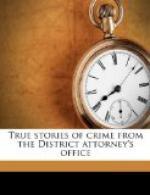On October 21st, Mr. House, Patrick’s lawyer, visited Patrick and Jones in the Tombs. Jones says that after Patrick had talked to Mr. House the former called Jones to one corner of the room and told him that House insisted on knowing definitely whether a crime had been committed and directed Jones to tell House that a murder had been committed, but that he (Patrick) was not concerned in it. This Jones declined to do without implicating Patrick. The two prisoners then returned to House and Jones says that he informed House that he had killed Rice by chloroform, and gave him the “same story which he told on the witness stand.” After this Jones apparently lost his nerve and told Patrick that he intended to commit suicide. This idea Patrick encouraged, agreeing that they should both do it at about the same time.
On the 26th of October Jones made a statement to Assistant District Attorney Osborne which was in large part false, and in which he endeavored to exonerate himself entirely from complicity in any of the crimes, and in which he charged the actual administration of the chloroform to Patrick. Four days later Osborne sent for him and told him he had lied, upon which Jones became confused, continued to persist in some of his statements, qualified others and withdrew still others. He was completely unnerved and that night attempted, by means of a knife which Patrick had supplied him, to cut his throat. The attempt was a failure, and he was removed to Bellevue Hospital, where he remained until November 12th. He then finally gave the statement which corresponded with his testimony upon the trial and which jibed with all the circumstances and evidence known to the District Attorney.
Did Patrick conspire with Jones to murder Rice? What corroboration is there of Jones’s story that he killed Rice under Patrick’s direction? First: What proof is there that murder was committed?
Roughly, that Jones so swore; that Rice died at the time alleged; that he did not die from disease, but that he died from a congestion of the lungs which could have occurred only in the case of a living organism by the administration of some such irritant as chloroform; that some one, therefore, must have killed him, and that Jones alone had the opportunity.
Second: What proof is there that Patrick directed the murder?
Evidence of an elaborate conspiracy, as briefly heretofore set forth, which contemplated the death of Rice. Of course Patrick wanted Rice to die. If Patrick was not implicated in the killing, what motive had Jones to commit the deed? Why did Rice die at the precise psychological moment which would enable Patrick to prevent two hundred and fifty thousand dollars on deposit being diverted to Texas? And finally, why did Patrick prepare a forged cremation letter for the destruction of the body? If the conspiracy contemplated a natural death, nothing could be of greater value to the two parties concerned than the means of proving that the death was not unnatural.




